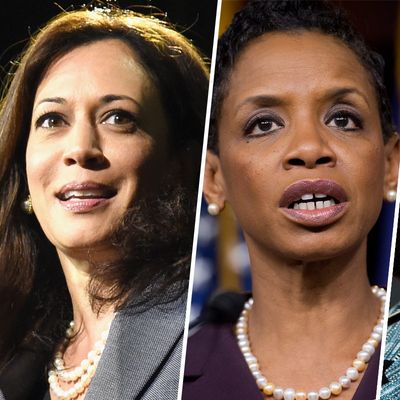
Every election year, after the votes are counted, everyone wants to assess how women fared. There are tallies of how many women were elected to the Senate, to the House, to governorships. There are assessments of the gender gap among voters. And then there are declarations. “Women were the real winners last night,” I wrote the morning after the 2012 election. The 2014 midterms, reported Time, were “kind of a dud for electing women.”
This year, with a woman as the front-running candidate for a major party, the narrative about women in politics has largely focused on Hillary Clinton. I’ve seen countless Facebook debates about the relative importance of voting for a woman — conversations that are merely proxy wars as the primary battle between Clinton and Bernie Sanders plays out on social media.
A realization has slowly sunk in: Nobody’s saying much about all of the other women running for office right now. There are currently 27 women in the running for the U.S. Senate, and 216 are vying for U.S. House seats. Plus six women running for governor. Not all of them will win their primaries to make it to the ballot in November. But there are hundreds of women campaigning right now — you’re just not hearing much about them.
The silence is a real shame, because in 2016 we could see a record-breaking number of women elected to the Senate. There are nine pro-choice Democratic women running for Senate this year, most of whom have a good shot at election. Compare that to the supposedly watershed “Year of the Woman” in 1992, which only saw four women senators elected. And, this year, four of the nine contenders are women of color, which is huge because only two women of color have ever, in history, been elected to the Senate.
Among the Senate contenders this year are Maryland’s Donna Edwards and California’s Kamala Harris, both African-American women. Harris, who is the attorney general of California, recently took on predatory for-profit colleges and supported a bill to disclose more information about police shootings. Edwards, a longtime community activist and sitting congresswoman, co-founded the National Network to End Domestic Violence and once worked on NASA’s Spacelab program. There’s also Tammy Duckworth, who is a veteran with a Purple Heart, an expert in international affairs, and a fierce advocate for disability rights. She’s running in Illinois. And in Nevada, Catherine Cortez Masto is pushing to be the first Latina ever elected to the U.S. Senate.
A not-insignificant number of women are running for Congress, too. “The thing that makes me excited about the House is the stories these women bring,” says Jess McIntosh, spokeswoman for EMILY’s List, which funnels money and support to pro-choice female Democratic candidates. “We’re past that model where a woman had a successful career or raised kids, and, instead of retiring, served in the House. Now it’s opening up.” Younger women, first-generation Americans, and a wide array of women candidates are on the ballot this year.
Denise Juneau, who’s running in Montana, would be the first Native American woman in Congress. And in Delaware, which has never elected a woman or a person of color to Congress, African-American woman Lisa Blunt Rochester is running. And Nevada’s Lucy Flores, who is open about the abortion she had at age 16 and has been a passionate defender of immigrants’ rights, is challenging a fellow Democrat for the nomination. Congressional races are smaller, from a national perspective, but still important. “The people we elect to Congress today are the ones we elect to Senate tomorrow,” McIntosh says.
Not all of these women candidates, it’s worth noting, have endorsed Clinton. And for those of us who are just voters — whether we’re Clinton superfans, merely lukewarm on her, or Sanders supporters who care about electing women — it’s time to look down the ticket. A lot of signs point to 2016 being a big year for women voters — especially if Donald Trump, who seems to actively hate women, is the Republican nominee. If we’re smart, we’ll use the wide gender gap among voters to lift women candidates at all levels of politics.
Here’s how to start: Rutgers’s Center for American Women in Politics has a list of women who are running in every state. Read it. Find a woman near you, or a woman on the other side of the country whose values you share. And decide to support her — financially, if possible. But in other ways, too. Volunteer. Talk her up. Do what you can. Many candidates are facing primary elections in May and June, so now is a great time to get onboard with their campaigns.
The 2016 election conversation has made “women in politics” seem synonymous with “Hillary.” It’s not. If we want to see a deep bench of women candidates, we have to bring ourselves to focus on state-level races. Now is the time to focus on the pipeline, so that no matter who’s elected president in November, we can honestly say this was another “Year of the Woman” — because we all helped ensure it would be.




